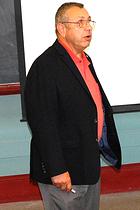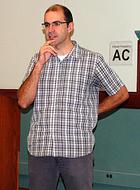 Industrial Engineering and Disaster Response Analysis: Methodological Challenges
Industrial Engineering and Disaster Response Analysis: Methodological Challenges
David Mendonca, Department of Industrial and Systems Engineering
In the immediate post-disaster scene, the appropriate instrumentation are rarely “on the ground” in time to measure target phenomena, whether those phenomena be social, technical, physical, or somewhere in-between. Indeed, particularly in the post-9/11 world, simply standing and watching the disaster unfold is sometimes impermissible. The focus of my work has been on the hows and whys of improvised decision making by emergency response personnel (such as fire, police and medical services). Examining this kind of non-routine decision making is doubly hard: not only is the “right” instrumentation likely to be missing, the typical ways of working are absent. Consequently, the human objects of inquiry may be less likely to recall correctly their thoughts and actions.
In this talk, I’ll discuss a few possible methodological remedies to this situation. The first remedy is to remap existing data streams to the measures you want (or something close to them). Editors tend to get nervous about this, but it can be done. A second remedy is to try to mirror salient characteristics of the target domain in a more controlled setting. This can get expensive, but again can be done. I illustrate both approaches (and discuss limitations) through my work with debris removal teams in the field, and emergency response organizations in the lab.
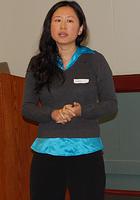 Sustainable Urban Transportation System (UTS)
Sustainable Urban Transportation System (UTS)
Cara Wang, Department of Civil and Environmental Engineering
The importance of the transportation sector in terms of energy and the environment is undeniable. The statistics show that in the United States, transportation consumes 29% of the total energy and 71% of the oil; and produces 26% of the greenhouse gases, 50% of the carbon monoxide, 32% of the nitrogen oxide, and 22% of volatile organic compounds. Transforming transportation is necessary for economic reasons, to mitigate global warming, and to reduce respiratory and cardiac problems associated with air pollution. At the same time, transportation is an engine of economic development and globalization. Official estimates indicate that transportation account for 10.3% of the USA Gross Domestic Product. Thus, increasing UTS sustainability will have a transformative effect on key layers of the economy, the environment, and quality of life. I will present several research projects that are currently going on in our program related to enhancing sustainability of UTS, including the implementation of Off-Hour Delivery in New York City, the noise reduction project, transit service quality investigation, dynamic transportation demand management enabled by mobile devices, and the trusted vendor program targeting at stimulating collaborative deliveries.
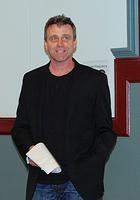 A Scientific Assessment of High-Volume Hydraulic Fracturing for Shale Gas and Oil
A Scientific Assessment of High-Volume Hydraulic Fracturing for Shale Gas and Oil
Yuri Gorby, Department of Civil and Environmental Engineering
Hydraulic fracturing for shale gas and oil has been applied in across the United States for over 60 years. However, recent advances in directional drilling technologies and high volume fracturing are changing the energy landscape in this country and throughout the world. Where conventional vertical wells were limited impact zones radiating a few hundred meters from the well bore, horizontal drilling technologies largely developed by the Halliburton Corporation can extend the radial zone of influence to nearly a kilometer in any direction. Once horizontal wells are installed and lined with cement and metal casings, 1 to 5 million gallons of water, toxic chemicals, and crystalline silica sand are injected at extreme pressure and velocity to fracture the shale formation and release gas and oil trapped within. Nearly 50% of the injected fluids are returned to the surface as flowback, condensate or produced water, which are defined by the stage at which they are generated. In addition to chemicals present in the injected “frack” fluids, the process liberates other components naturally present in the formation, including toxic volatile organic compounds, uranium, radium, radon, bromide, sulfate, and other materials deposited hundreds of millions of years before present. These toxic waste streams must be transported from the well site for treatment or disposal.
This short presentation will identify significant gaps in scientific knowledge related to the short and long term impacts of high volume hydraulic fracturing and related activities to human and environmental health. Suggestions for filling these gaps will be discussed.
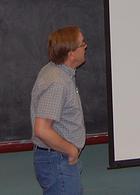 Image Analysis Algorithms for Individual Animal Recognition and Species Detection
Image Analysis Algorithms for Individual Animal Recognition and Species Detection
Chuck Stewart, Department of Computer Science
The study of a wide range of problems in ecology, botany and zoology may be enhanced substantially through the collection and tagging of images taken individually by scientists or citizens, or automatically by video recording devices, webcams or camera traps. The overwhelming volume of imagery usually produced necessitates the development of automatic image analysis techniques. This presentation will discuss two current projects at RPI. The first, the Hotspotter project, automatically recognizes previously-seen individual animals in new photos for species such as zebras, giraffes and leopard. The most recent version of Hotspotter, requiring just a few seconds to recognize one of a thousand or more individuals, is currently in use in Kenya. The second automatically detects and counts scallops, sand dollars, clams and similar species in imagery of the ocean. The techniques used in both projects may be applicable to a range of related problems.
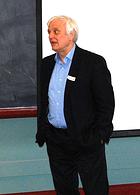 Understanding Resilience of Infrastructure Networks
Understanding Resilience of Infrastructure Networks
Andrea Asztalos, Gyorgy Korniss, and Boleslaw Szymanski
Social networks, the Internet, the world wide airline network and the electric power grid are all examples of large-scale systems that we are constituents of or that we rely on, often unconsciously, in our everyday life. These are networked systems made up of many non-identical elements – nodes – connected by diverse interactions and often they are interdependent on each other. As our daily life imposes increasing demands on these networks, they become more exposed to common vulnerabilities, failures, malfunctions, both induced internally or externally (e.g. by extreme weather conditions). One of the common vulnerabilities of such systems is cascading failures, a dynamic process that can be initiated by the failure of a single or a very few nodes that can iteratively lead to more failures eventually resulting in the global breakdown of the whole system. Examples include electrical blackouts, failures of financial institutions or mechanical structural failures. The resulting damage is the cumulative effect of the spread of failures rather than a single event contributing to the large-scale damage of the network.
Our work is theoretical and focuses on understanding sources of vulnerability and robustness of networks from a design perspective. We analyze cascades of overload failures taking place in networks carrying a flow of abstract resource which could represent electric current, data packets, gas, etc. Each node and edge in the network carries a load that in the unperturbed state is below a certain capacity. Once the network is perturbed by the removal of a node/edge the flows get redistributed resulting in new loads on the nodes and edges, respectively. If the load at any node/edge is higher than the respective capacity, the node/edge becomes overloaded and it fails. I will present how a simple design strategy for allocating link weights produces balanced load profiles that not only assures optimal transport efficiency of the network but simultaneously guarantees maximal resilience to cascades of overload failures. Preliminary results are related to various network defense strategies that can prevent the propagation of overload failures through the entire network as well as a comparison between spatially concentrated and randomly distributed, but weaker, simultaneous breakdowns.
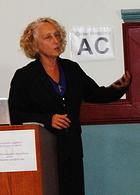 Interdisciplinary Arts Practice for Creative Place-making: “Found Art in North Troy”
Interdisciplinary Arts Practice for Creative Place-making: “Found Art in North Troy”
Branda Miller, Department of the Arts
My ongoing research is on the role of community media and participatory interdisciplinary arts practice in fostering community interaction and development. I will present the new project “Found Art in North Troy,” funded by the National Endowment for the Arts “Our Town” grant and matched by the City of Troy. This hyper-local model of creative place-making is designed to transform one historically troubled, neglected block of 6th Avenue between Glen Avenue and 101st Street into an engaged hub for public art, interdisciplinary creative practice and education, festivals, performances and cultural exchange.
Found art serves as a metaphor for the historic neighborhood itself. Integrated the re-use of discarded resources of our landscape, we will address themes of re-purposing and sustainability. The project draws attention and builds involvement organically following the unique rhythms of life in our neighborhood. Interdisciplinary arts education guides our research process, designed to enhance livability of an economically impoverished neighborhood. The project addresses endemic urban environmental and public health challenges facing residents of North Troy by engaging the community in creative problem-solving and collective action centered on improving infrastructure, beautifying our public space, and envisioning alternatives. We will use photography, video and creative writing to give voice to a community. We will archive community action plans and design charrettes, workshop lesson plans and media reports. Artists work in qualitative terms: this is a great opportunity to merge the strengths of humanities and social sciences to document and evaluate outcomes, measure growth of community engagement and changes in perception both by local neighbors and regional visitors.
Chang Ryu and James Crivello, Department of Chemistry
One of the major challenges for polymer chemists in this century will be the replace of petroleum by biomass as a source of raw materials for plastics. There has been an increasing awareness that the world has become almost entirely dependent on petroleum as a raw material sources for the all-pervasive plastics industry. The strategic vulnerability of the intrinsically-limited and now-renewable petroleum supply due to various geopolitical factors has led to a world-wide search for alternative and sustainable sources of basic raw materials. Innovative approaches to the solution of this multifaceted problem will have major economic and societal consequences for the global community. Any successful solutions must address the critical issues of the minimization of energy consumption and environmental pollution at all stages of monomer and polymer production. Further acceptable solutions must also consider factors, such as the cost and availability of the starting materials as well as the added cost of any chemical modification processes in monomer synthesis. Lastly, it is highly desirable that the “green” technology must lead to polymer materials with valuable physical properties to replace their petroleum-derived counterparts. In this presentation, the development of photo-initiated polymerization of epoxy polymers from renewable resources, such as vegetable oil and lipids, will be briefly discussed in conjunction with the green chemistry initiatives in the Chemistry Department at Rensselaer.
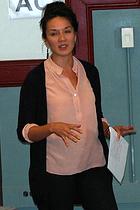 Sustainable Communications: Visual Design for Social Change in Food Technologies
Sustainable Communications: Visual Design for Social Change in Food Technologies
Leah Rico, Department of Media and Communications
What does it mean to communicate sustainably? Sustainable visual design deals with more than the lifecycle of material production. The exponential growth in the visualization of our day-to-day experiences means that the persuasive power of communication bears more weight than ever before. Our increasing connectivity through developments in everyday technologies means that messages travel widely and immediately. We continuously learn and navigate a dynamic landscape of media, devices and messages. The role of the visual communicator, then, becomes one of finding and using the most effective and clear way to talk to audiences. The responsibility of the visual designer is to use their skills to distribute ideas that the world really needs.
Sustainability in visual design means using design thinking to empathetically understand the context of the problem, creatively brain storm solutions, and rationally fit them to the original context. Do traditional methods work, or can we innovate to find something more appropriate? Is there a better question to be asked? What is the best means of messaging to reach a desired audience? The landscape of design is not “window dressing”; it is a collaborative process with policy holders, industrial designers, architects, urban planners, and audiences to disseminate data.
There is currently an explosion of interest in local food, with an overwhelming amount of information (and misinformation) for farmers, distributors and consumers. My current design research investigates how innovative communication design and ubiquitous technology can facilitate connections among these groups, create means for each to navigate dynamic information and data, and help build on person-to-person relationships among all stakeholders. In this talk, I’ll discuss the role and value of designers in visually representing complex information and experiences in food technologies. Specifically, I’ll look at the notion of building a platform to enable the discovery of information as it applies to sourcing locally produced, sustainable food products using networked technology.
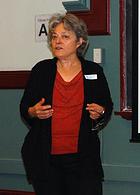 The Economics of Sustainability
The Economics of Sustainability
Faye Duchin, Departments of Economics and STS
Economics is concerned with resource extraction for the production, exchange, and consumption of goods and services. It is generally aimed at promoting growth by allocating scarce resources efficiently among competing demands. I present a conceptual framework and operational model that can prioritize sustainability objectives over growth and efficiency. To illustrate these ideas, I report results from two recent empirical studies about the future ability of global agriculture to satisfy growing demand for food taking account of limited availability of arable land and fresh water. My colleagues and I find that future demand can be satisfied sustainability but that agricultural production will shift significantly from developed regions of the world to developing regions, mainly Africa and Latin America. In a second study that distinguishes agricultural regions within Mexico by hydrological criteria, we find that the lowest costs correspond to irrigated crop production in dry regions that currently use water unsustainably. In scenarios where their extraction of water is constrained, other regions of the country take up the production slack. However, these are not the most water-rich regions, which turn out under all scenarios to be the highest-cost agricultural producers. Ongoing research addresses: (1) the material needs and interests of the stakeholders in agricultural transformations in developing countries, (2) the representation of alternative farming technologies in our mathematical models, and (3) improved estimates for endowments of land and water.
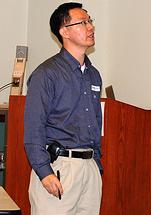 Functional Polymer Materials for Clean Energy and Environment Technologies
Functional Polymer Materials for Clean Energy and Environment Technologies
Chulsung Bae, Department of Chemistry and Chemical Biology
Chemistry plays an important role in development of new technologies for clean energy and sustainable environment. My research group has been working on development of new materials that can advance such technologies. Hydrogen has been touted as the cleanest fuel for transportation sector for many years (so-called the Hydrogen Economy). When hydrogen fuel is consumed in an electrochemical device (i.e., fuel cells), it reacts with oxygen in air and generates electricity and water is the only by-product. In clean energy-related projects, I will present current status of hydrogen fuel cell technology, challenges of implementation of the Hydrogen Economy, and my group’s recent contribution to fuel cell technology using chemical reactions that we recently discovered.
To be economically viable, many chemical reactions require a catalyst to accelerate product formation. Unfortunately, removal of catalyst in separation process is difficult, consuming lots of energy and increasing the overall production cost. In clean environment-related projects, I will present the importance of catalyst in industrial chemical process and development of our easily recyclable catalyst for green chemistry application.
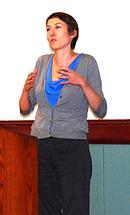 Sociology of Environmental Knowledge
Sociology of Environmental Knowledge
Abby Kinchy, Department of Science and Technology Studies
Sociologists study human social life at multiple scales, from fleeting encounters of individuals on the street to world-wide social structures and transformations. Sociology has a great deal to contribute to sustainability studies. Environmental problems such as pollution and natural resource depletion are not only problems for society, affecting the way we live our lives; they are also problems of society—the result of patterns of social organization and social practices. There is an emerging body of sociological research that seeks to discover the social processes that produce ignorance, or “undone science,” about environmental hazards. For example, sociologists are now studying the institutional and policy conditions that direct resources away from research on the environmental causes of chronic disease. My current research project examines the production of knowledge about the environmental impacts of shale gas development—a controversial new source of fossil fuel energy in this region. The research methods are designed to identify communities and watersheds that have received the most and least public investment in watershed monitoring, and to explain the reasons for this variation. I use both quantitative and qualitative methods of analysis, including GIS mapping of monitoring locations, in-depth interviews with watershed scientists, regulators, and environmental protection groups, and historical case studies. This project has immediate opportunities for interdisciplinary collaboration, particularly in the fields of freshwater conservation science and aquatic ecosystem studies. Several natural scientists and environmental regulators working these domains have already expressed interest in the findings. More broadly, the research approach developed for this project could be the basis for future interdisciplinary projects addressing a wide range of questions about the production of environmental knowledge.
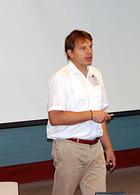 Efficiency Gains to the Rescue – a Discussion on Lighting
Efficiency Gains to the Rescue – a Discussion on Lighting
Christian Wetzel, Department of Physics
Solid state lighting has identified an opportunity for tremendous energy savings by virtue of essentially re-inventing artificial lighting as a whole. Technical challenges have been overcome by the convergence of multiple disciplines. The Smart Lighting Center at RPI has taken the role to drive the enabling materials research through the development chain into system level benefits. I will iterate some of the challenges as they pertain to the aspect if sustainability.
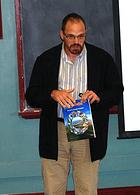 Some Materials Science Perspectives on Sustainability
Some Materials Science Perspectives on Sustainability
Vincent Meunier, Departments of Physics and Materials Science Engineering
Materials science covers a wide range of activity and touches on many different fields of physical sciences, including chemistry, biology and physics. As diverse as it is, materials science approaches materials from a unified point of view by considering connections between the underlying structure of a material, its properties, how processing changes it, and what the material can do. Past practices consisted in changing materials by trial and error, working essentially on a big, visible scale. Modern materials scientists manipulate and change materials based on fundamental understandings of how the materials are assembled, most often at the indivisible – atomic – scale.
From a material science vantage, renewable resources can be defined as ones that are supplied by the Earth (or Sun) and replenished at rates commensurate with the time scale of human consumption and potential impacts. Non-renewable materials, including mineral deposits and fossil fuels, recycle on a geological time scale in excess of millions of years. When the consumption rate of a resource becomes too high (due to population growth and standard-of-living increase), materials once thought to be renewable effectively become nonrenewable. Therefore, any material science sustainability solution calls for a profound shift in thinking that accounts for all the resources available, including those that do not follow patterns established by the existing technological landscape. This presentation will describe emerging and potential research in this direction.
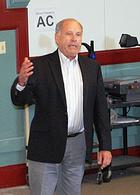 The Pursuit of Sustainability in Business Management
The Pursuit of Sustainability in Business Management
David L. Rainey, Acting Dean, Rensselaer at Hartford
The Pursuit of Sustainability focuses (POS) on strategic leadership, holistic thinking and innovative management constructs for developing and delivering cutting-edge solutions and systems. Sustainability is a not only a hot topic, but one that engenders very favorable views in the minds of people. It has a positive ring to it and companies that claim to embrace sustainability are trying to enhance their reputations and to achieve outstanding performance. However, the notion of sustainability is more often used improperly rather than in its true sense. In reality most of companies are just at the beginning of their POS. The basic difficulties include a lack of a generally accepted definition of what sustainability truly means, deficiencies in articulating the requirements necessary for achieving sustainability, and the confusion in terms of what measures can be used to validate the necessary outcomes and performance. One of the most serious concerns is how does a company prove that it is sustainable or that it has achieved a level of sustainability when making such claims. Often companies declare that they have reached sustainability when they have launched waste minimization and pollution prevention initiatives. While such actions are commendable, they are fairly modest approaches in the POS. For instance, some business leaders believe that recycling programs and the use of recycled materials in their products or processes qualifies them as being sustainable. Such initiatives are good and useful, but they still involve managing waste streams after they have been generated or solving problems instead of avoiding creating the wastes or problems in the first place. POS involves making transformations to higher levels of sophistication.
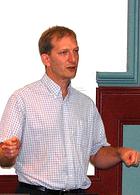 Developing Resilient Cyberinfrastructure in Support of Resilience Research
Developing Resilient Cyberinfrastructure in Support of Resilience Research
James Myers, Department of Computer Science, CCNI
Resilience (sustainability under steady-state conditions and in the face of rapid or long-term change) is inherently holistic. Thus research related to the analysis of resilience, and the engineering or resilient systems, requires multi-scale, multi-dimensional, multi-disciplinary approaches. In the NSF supported Sustainable Environments – Actionable Data (SEAD) DataNet project, we are reflexively applying a resilience-based approach to create a data-integration and curation environment specifically designed to support multi-disciplinary sustainability/resilience research. In designing the project and the software for SEAD, we have looked at the role of a community data repository within the overall ecosystem of research resources and analyzed ways to enhance the return on investment for data producers, consumers, and curators across the research lifecycle and with recognition of the long-tail distribution of research projects and the dynamic nature of project funding. This type of analysis has led to specific architectural choices and to new concepts such as active and social data curation that promise to simplify and accelerate data discovery, ingest, documentation, integration, analysis, and publication. In this presentation, I’ll focus on how SEAD’s novel features (e.g. managing heterogeneous data formats, supporting rich descriptive metadata and provenance information, providing previews of individual data sets and spatial and temporal data integration capabilities, and supporting data publication and long-term preservation) are directly derived from a resilience methodology for Cyberinfrastructure development.


